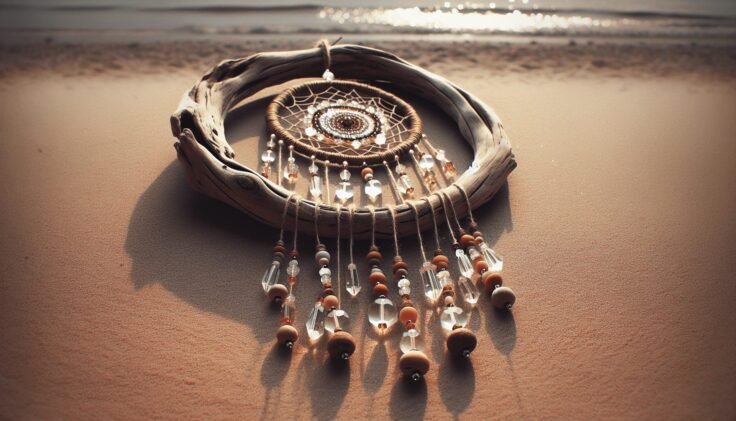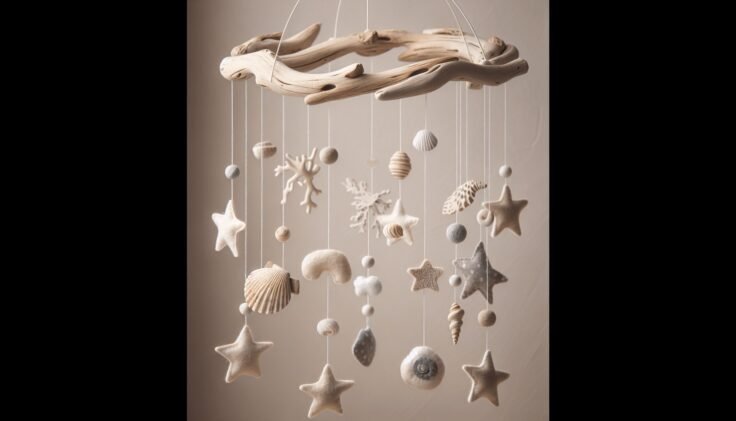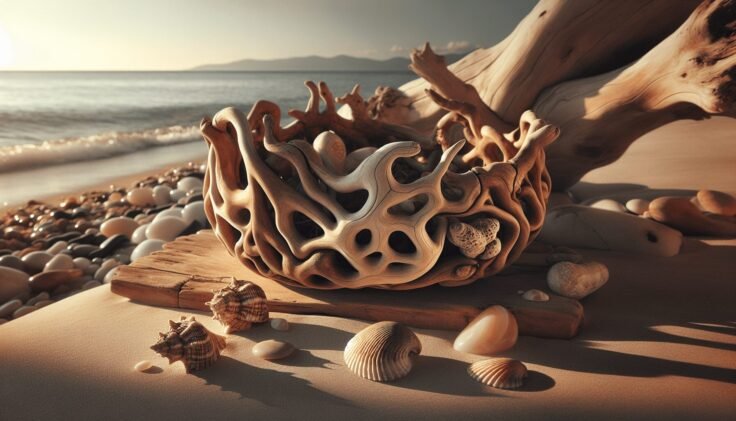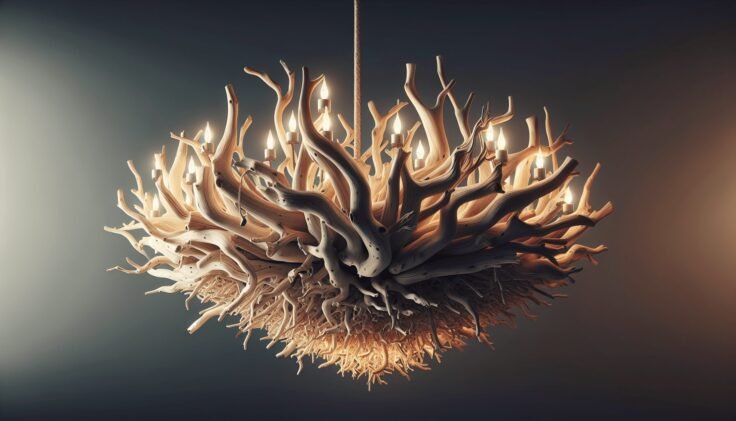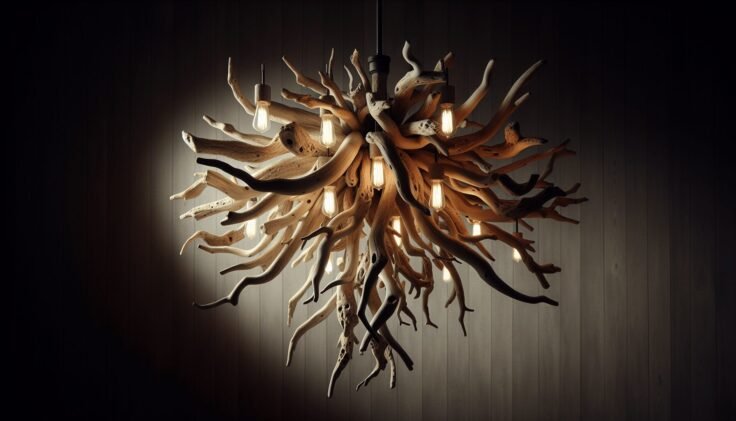Have you ever stumbled upon a piece of driftwood on the beach and imagined it transformed into something magical? Driftwood birds capture the beauty of nature in a delightful way by turning these ordinary pieces into extraordinary art. This charming hobby combines creativity with nature’s raw beauty. Let’s explore how you can create and appreciate these unique art pieces.

Driftwood: Nature’s Art Supplies
Driftwood refers to wood that has been washed ashore by the action of winds, tides, or waves. Over time, it gets sculpted by nature into fascinating shapes. This type of wood is often used by artists and crafters because its distinctive form and texture provide endless possibilities for artistic expression.
The Birth of Driftwood
Driftwood begins its journey as trees in forests, edges of rivers, or near coastal areas. Falling into water bodies due to storms, erosion, or other natural processes, the wood travels long distances. Along the way, it is stripped of its bark and branches, smoothed by water currents, and sometimes bleached by the sun and salt, gaining a unique appearance.
Uses of Driftwood
Artists and hobbyists prize driftwood for its versatility. It’s used to create sculptures, furniture, and decorative items. Driftwood birds, in particular, stand out for how they embody the spirit of both nature and craft, capturing the essence of avian beauty in rustic forms.
Crafting Driftwood Birds: A Creative Adventure
Creating a driftwood bird requires careful selection, imagination, and a bit of skill. You don’t need to be a seasoned artist to start; just bring your love for nature and creativity!
Gathering Materials
Collecting driftwood can be a delightful treasure hunt. Look for pieces that inspire you. Consider their size, shape, and weight. You might find pieces that resemble bird parts—a body here, a neck there, or maybe a pair of wings waiting to take flight.
Essential Tools:
- Sandpaper: Smoothens rough edges.
- Glue: Joins pieces together.
- Wire: Provides structure and flexibility.
- Drill: Useful for making holes if needed.
- Paints and Brushes: Add color to your bird.
Crafting Techniques
Start by laying out your pieces on a flat surface. Visualize the bird’s form. Will it be a majestic eagle or a tiny sparrow? Use sandpaper to refine the texture. Connect the pieces with strong adhesive, ensuring stability. You might need to drill and wire parts together for more complex figures.
Adding Details
Let your imagination soar! With paints, your bird can be vibrant or stay natural with a clear sealant. Incorporate additional elements like pebble eyes or feather-like textures using smaller wood pieces or leaves.
Inspiration From Nature’s Aviators
Many artists draw inspiration from real birds. Observing birds, either in books or in the wild, can enrich your creative process. Real-life bird behavior and anatomy offer insight into creating more realistic or stylized driftwood birds.
Types of Birds to Create
The variety of bird species means unlimited possibilities for driftwood creations. You may start with something simple like a robin or go for the exotic beauty of a flamingo. Each type requires different shapes and sizes of driftwood, encouraging you to push your creative limits.
- Small Birds: Sparrows or robins are excellent for beginners.
- Medium Birds: Consider doves or owls for a bit more challenge.
- Large Birds: Eagles or herons offer a dramatic flair.
Displaying Your Driftwood Bird
Once your bird is complete, choose a fitting way to display it. Whether it becomes part of your home decor or a special gift, presentation matters.
Indoor Display
For an indoor setting, place your driftwood bird on a wooden base or a shelf. The rustic elegance of driftwood complements many home styles, from modern to coastal.
Outdoor Display
You could also place your creation in a garden or porch. Driftwood naturally withstands the elements, but consider applying a UV-resistant sealant for added protection.

Driftwood Birds’ Role in Art and Culture
Driftwood artwork is not just a hobby but a significant expression in art culture. It reflects sustainability, creativity, and a deep connection with the environment.
Environmental Impact and Sustainability
Using driftwood is an eco-friendly practice. By turning waste into art, artists promote recycling and raise awareness about ocean preservation. Each driftwood bird is a testament to the possibility of beautiful, sustainable art practices.
Significance in Various Cultures
Driftwood art has historical roots. In coastal cultures, it’s common to find driftwood items intended for spiritual or practical purposes. Today, driftwood birds add artistic and cultural flair, continuing a tradition of celebrating nature’s gifts.
Driftwood Artists to Admire
Several artists specialize in driftwood creations and inspire others through their works. Find artists whose style resonates with you and draw inspiration from their methods and finished pieces.
Learning and Growing as a Driftwood Artist
As with any art form, the more you practice, the better you become. Learning new techniques and striving for realistic or abstract representations will refine your skills.
Join Workshops or Take Online Classes
Structured learning can enhance your crafting skills. Workshops or online courses often cover techniques, materials, and new ideas, providing opportunities for growth and connection with fellow enthusiasts.
DIY Books and Video Tutorials
There are numerous resources available for budding driftwood artists. Books and online videos can provide step-by-step guides, helping you to expand your creative repertoire.
The Joy of Sharing and Selling Driftwood Birds
Creating driftwood birds can be more than a personal hobby; it can also become a source of joy shared with others through gifts or sales.
Gifting Your Creations
A handmade driftwood bird is a thoughtful gift. It’s personal and showcases the effort and care put into your creation, making it a cherished keepsake for the recipient.
Selling Your Driftwood Art
If you wish to sell your driftwood birds, consider venues such as craft fairs, online marketplaces, or local shops. Ensure they are well-presented and priced appropriately for your market. Feedback from buyers can refine your skills and boost your creative journey.
Building an Online Presence
Building an online portfolio or social media presence helps share your art with a broader audience. It’s a chance to connect with other crafters, share ideas, and inspire more people to appreciate driftwood art.
Conclusion
Driftwood birds are a beautiful fusion of nature and creativity, offering an innovative way to appreciate the wind, water, and trees. Whether you are making them for personal enjoyment, sharing them with friends, or selling them, the journey of turning driftwood into avian art is both rewarding and fulfilling. Next time you’re at the beach, let your imagination roam free, and perhaps a weathered piece of wood will inspire your next creation.
